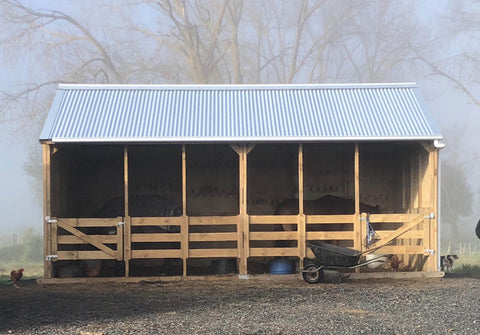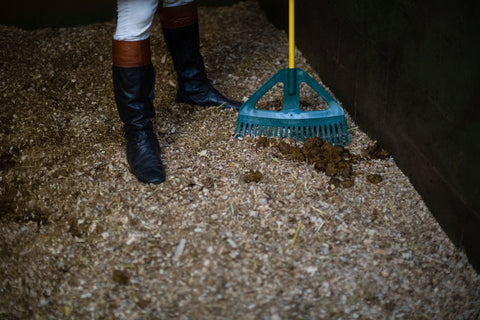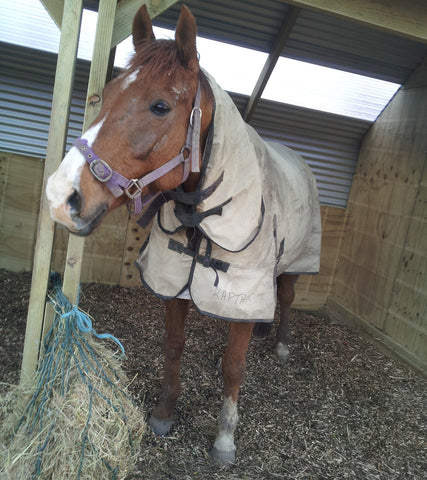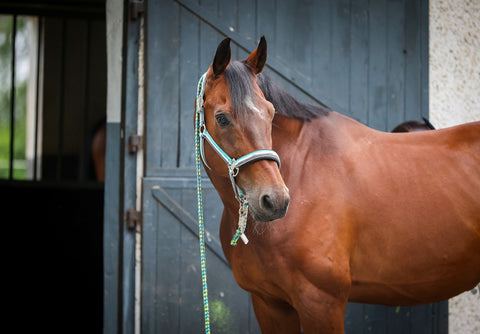The pleasures of owning and riding horses comes with all the responsibilities of looking after them. From keeping them well fed, sheltered and comfortable, to happy, healthy and clean. A well kept horse stable will take care of the second half of the list and is well worth keeping on top of.

To clean your horse stalls you’ll need to remove all the waste first before you clean all the surfaces and re-lay the bedding. Keep your tools for mucking out in one place so they’re easier to find and replace and make sure to empty, clean and refill water buckets and feed.
No one likes the idea of cleaning out a horse stall and if we can find ways to work more efficiently and effectively to speed up the process, we’d all jump at the chance. For this reason, we’ve collected some ideas and tips to fast and effective stall cleaning to get you out on horseback and into the paddocks as soon as possible.
GET A FREE COPY OF OUR CATALOGUE
Why do I need to clean my horse's stall?
Keeping your horse's stall clean is more than keeping it looking and smelling nice for you both. Unclean stalls attract insects and can harvest disease. In addition to this, wet bedding can encourage a lot of different hoof problems such as thrush. Urine saturated bedding leeches ammonia into the air which is harmful to your horse or pony’s lungs.
For this reason, it is essential to keep a clean stall and disinfect it regularly. Each horse will have different habits and you’ll slowly learn the best tips for cleaning out your horse's stall for optimal comfort, health and hygiene.
If you keep a good stall cleaning routine you will be able to spot any changes in your horse's behaviour. Should their pooping or eating habits change you can catch it early, in case something more serious is going on with their health.

What tools do you need to clean a horse stall?
As with many things, a well planned cleaning spree will save you both time and energy. First of all, make sure you have all the equipment you will need on hand, invest in stalls with a tack room attached so that they are easily accessible. The right tools make any job easier. This will also save you stopping and starting to find the tools you need.
You will need the following:
- Muck or pitch fork for straw or bedding hay. If you use shavings or wood pellets for bedding, you’ll want a bedding fork with tines that are close together.
- Wheelbarrow for collecting soiled bedding and manure.
- Stable broom for sweeping the floors clean.
- Flat-bottomed shovel for scraping matter off the floors.
- Face mask or bandana for dusty stalls.
- Work gloves to save your hands.
- Rubber boots are easier to clean.
- Watering can to dampen any dust.
- Fresh shavings for the bedding.
- Stiff bristled scrub brush.
- Odour-control agent.

How to clean horse stalls
Follow these steps to effectively create a clean and healthy stall for your horse. A good routine can help you to keep cleaning times to a minimum and riding time to a maximum.
1. Dress appropriatelyThis job is going to be messy so you won’t want to ruin your best riding gear. Urine can also erode stitching on the soles of leather riding boots, so work gloves and rubber boots are ideal.
2. Prepare the stallTry to keep your horse out of the stall while cleaning. The best time to clean is when they are out in the pasture or exercising. Remove feed tubs, water buckets and toys from the stall before cleaning.
Remember to park your wheelbarrow close to the stall door in the direction you will go towards the manure pile as it’s easier to manoeuvre an empty wheelbarrow than a full one.
3. Remove leftover hayAny soiled hay can go in the wheelbarrow to be discarded. If the hay is still good it can be swept into a corner to be used again.
4. Remove any visible manure and sodden matterIt’s best to remove these first before you dig further into the bedding to avoid mixing it up.
5. Turn over bedding against a wallIt’s best to use the wall with the cleanest bedding but it’s hard to know what lies below before you start turning.
6. Toss the rest of the bedding against the clean wallDump any wet bedding you find into the wheelbarrow. Any dry bedding, you can toss against the wall at about hip height. As the bedding hits the wall, the clean bedding will pile up and any manure falls to the bottom of the pile. Once the manure builds up at the bottom of the clean bedding pile, you can scoop it up and toss it into the wheelbarrow.
Finish turning over the whole stall in the same way. Include the bedding under the water and feed buckets and the hay rack. Minimal hay left strewn through the bedding will be fine.
If the bedding is dry and dusty, wear a mask or bandana to protect yourself. Alternatively, you can sprinkle some water with a watering can to dampen the dust, but don’t over do it.
7. Treat any wet spotsSweep any wet bedding off the floor with a shovel if you have stall mats or concrete flooring. A dirt floor will require you to scrape the spot with a manure fork. If there is a bad odour, you can use an odour or moisture-absorbing agent and let it air-dry before re-bedding the stall.
8. Re-bed the stallPull the shavings away from the clean wall with a manure fork and spread them across the stall. You can use the old bedding in the wet areas first. Be sure to catch any manure that was missed in step 4.
9. Add fresh beddingPut the fresh bedding on top of the old bedding, distribute the bedding evenly across the floor, fluff with a pitchfork and return the leftover hay.
The thickness of your bedding will be reflected by the type of flooring in the stall and what season it is. With the use of thick rubber matting on the floor, bedding can be thinner. Bare concrete will require more bedding for padding and urine absorption. This is especially important during cold weather. Some people might put a thick bedding in the cooler months and only clean the top layer.
10. Clean alleys and doorwaysUse a broom to clean up any spilled manure, straw or shavings in the alleys and doorways to the stable. If left strewn about, all this matter can turn into a muddy mess in wet weather.
11. Remove, clean and refill water bucketsUse a stiff-bristled brush to scrub the water buckets outside and refill them with fresh water. The reason this step is last, is so you don’t mess up the freshwater while cleaning the stall.
12. Finishing upTo avoid tripping hazards and losing tools, make sure you put them all away in the tack shed or where they belong.

How long does it take to clean a horse stall?
Stall cleaning should be a daily task and typically doesn’t take more than 20 minutes for a quick clean when you first start out. If you have neglected to clean your stall for more than a day then your stall clean will obviously take longer than this. This is a good reminder to keep a regular schedule of daily cleaning to avoid having to spend longer than needed and deal with the build up of excrement.
Tips for more efficient stall cleaning
1. The type of fork you use
Believe it or not, shavings or wood pellets are known to be easier to clean than straw or bedding hay. With straw, you’ll need to use a pitch fork which can be cumbersome. With pellets and shavings you can use a lightweight bedding or manure fork with closely spaced tines. It works like a giant kitty litter scooper to pick out manure and wet spots.
2. The right sized wheelbarrow
Invest in a barrow that’s big enough to comfortably carry a large load of old bedding and manure, to save you running backwards and forwards to the manure pile. The body of the barrow should be a lightweight plastic and a model with a single wheel in front will enable better manoeuvrability.
3. Carry a muck bucket with you
A muck bucket on hand means you can quickly pick up after your horse when you are in the barn. Picking it up as you go reduces fly problems and helps a lot with stall cleaning.
4. Invest in stall mats
These thick rubber mats are astonishingly durable and make a great investment for your stalls. You may consider them expensive but they will definitely save you money on bedding in the long run. Use of stall mats also helps prevent hoof, leg and joint problems which can also save you tremendously in vet bills.
5. Let your horses out to pasture
Horses are used to spending their time outside. The good thing about this is, the longer they spend on pasture, the less mess you will need to clean up! In good weather try to keep them outside for as long as possible to avoid more mess in the stalls.
Contact one of the Outpost Team today for more information





